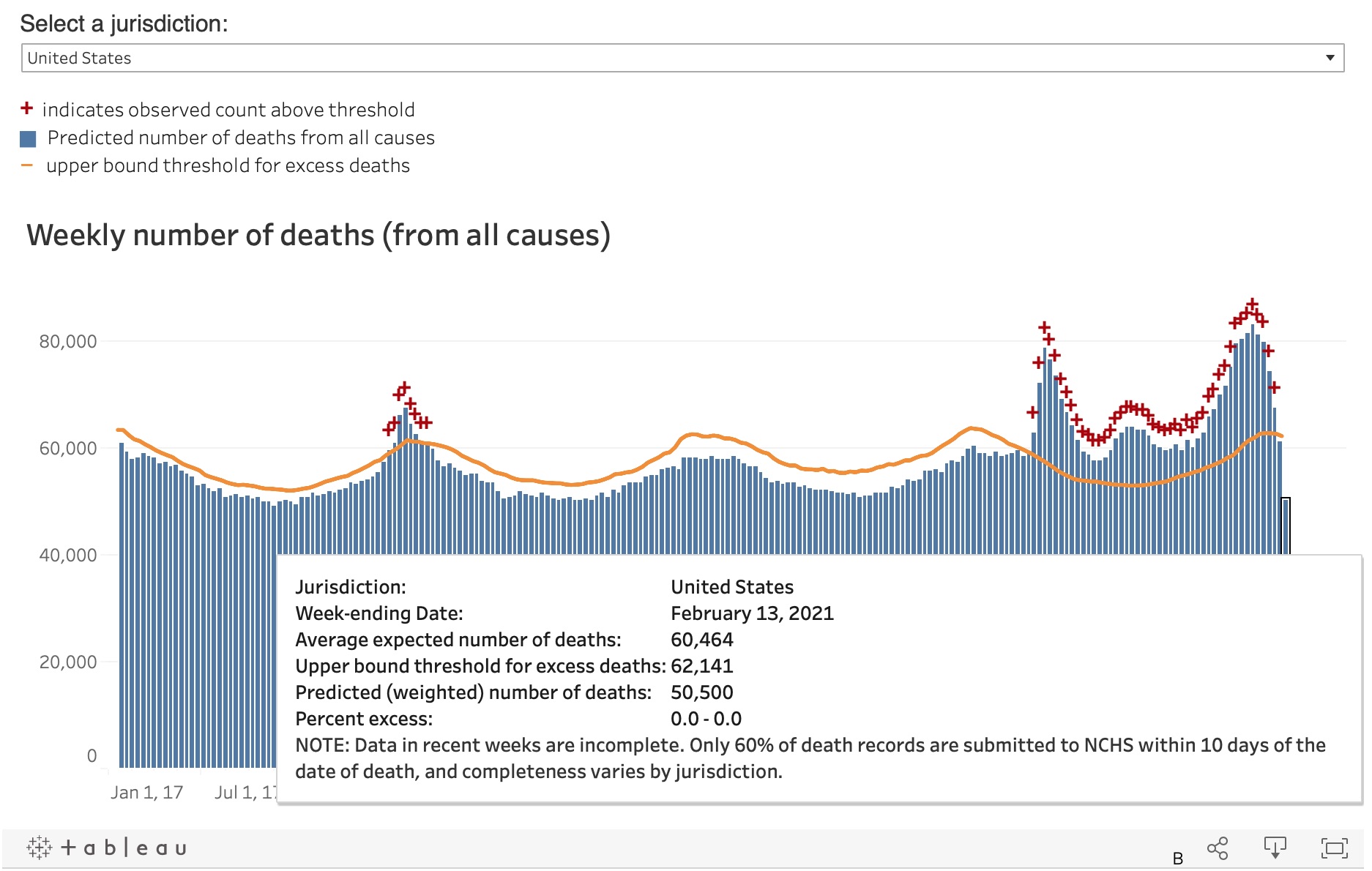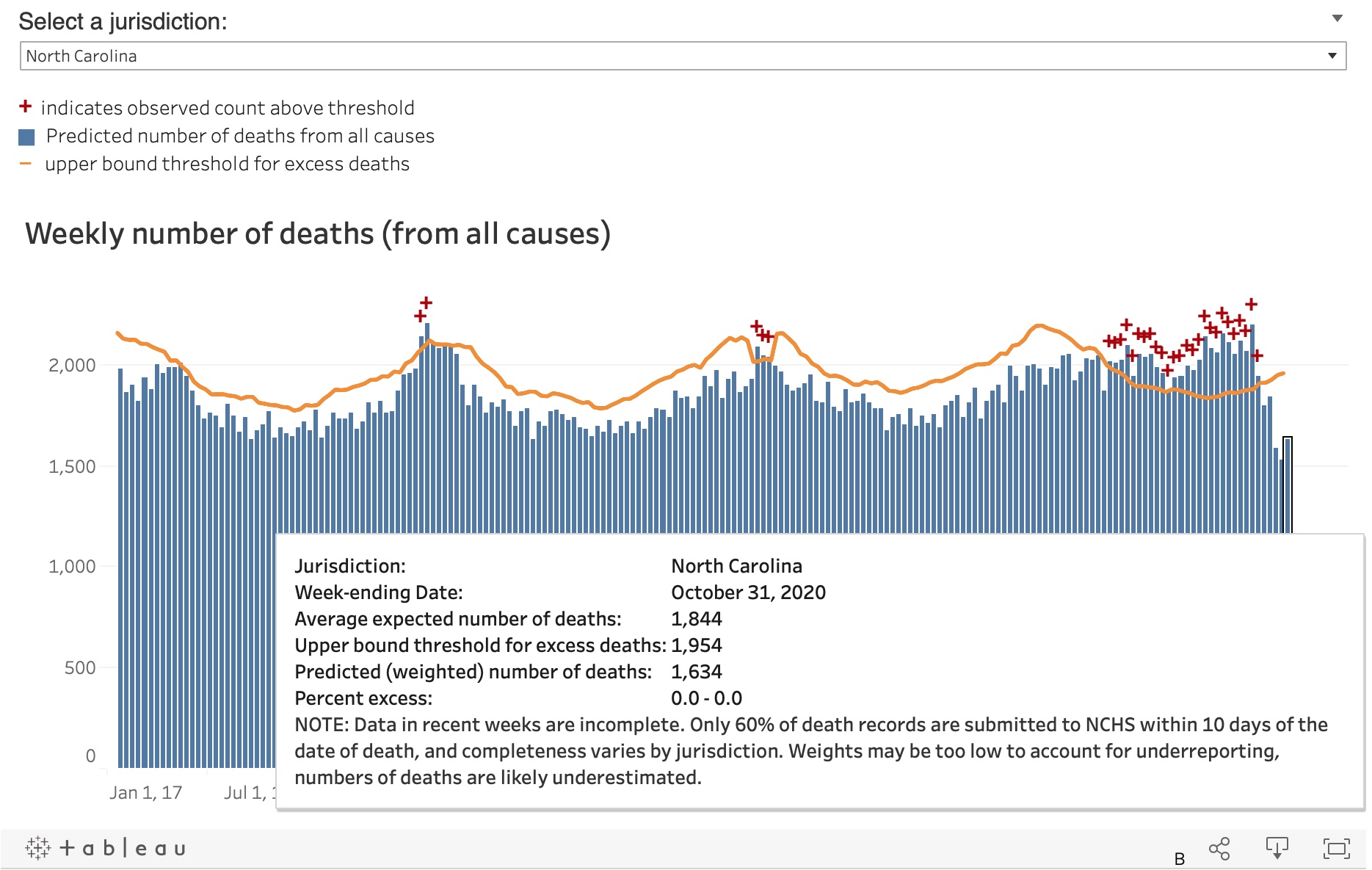- Research warns that government lockdowns and severe personal and business restrictions may be deadlier than the virus they’re meant to protect people from
- An earlier research brief using data from the CDC and DHHS showed that NC was suffering excess deaths without even counting COVID-19 deaths, but DHHS data reporting is so far behind, it’s incomplete after late September
- Meanwhile, Gov. Roy Cooper was steadily increasing restrictions on people and businesses heedlessly
It is now the month of March 2021. Gov. Roy Cooper has been issuing executive orders outside the bounds of the Emergency Management Act for a year. Nevertheless, media and large numbers of frightened North Carolinians seem tranquilized by the notions that the governor is doing what has to be done to protect our very lives and that his decisions are based in sound science and data.
If we are to presume Cooper is issuing these orders out of concern for the health and safety of North Carolinians, and that he is “following the science” in so doing, then why doesn’t he seem the least bit concerned about the increasing warnings from scientists, physicians, economists, mental health experts, and others about the greater dangers from government lockdowns and restrictions?
Here are only a few examples:
- A December 2020 National Bureau of Economic Research working paper from professors at Duke University, Johns Hopkins University, and Harvard Medical School, estimated that the death toll from the economic impact of lockdowns and other government COVID containment measures could far exceed that of the virus itself over the next 15 to 20 years
- A review of 31 technical reports to scientific manuscripts for the American Institute for Economic Research found that “the evidence emphatically questions the merits of lockdowns and shows that lockdowns have been an abject failure, do not work to prevent viral spread and in fact cause great harm“
- A survey released in the summer of 2020 by the Centers for Disease Control and Prevention (CDC) found that COVID-related lockdowns, social distancing policies, lives lost, illnesses, jobs lost, and financial insecurity were causing increased anxiety disorders, depressive disorders, substance abuse, and even suicides, and it included the finding that one in four young adults had “seriously considered” suicide in the past 30 days
- A February 2020 report by NPR recounted increased suicides, suicide attempts, and mental-health hospitalizations by K-12 students across the nation
- Remote schooling has sparked warnings about the drop-off in child abuse reports and foster placements in North Carolina, since teachers and school staff are responsible for discovering one-fourth of cases of child abuse and neglect — as reported by The News & Observer, “experts fear that multiple stressors — including wage and job loss, psychological challenges and health issues — are actually driving up child abuse and neglect cases hidden in the shadows of the pandemic”
- Physicians and professors warned back in May in The Hill that the lockdowns were already costing more lives than they were saving
- The CDC released a study showing that drug overdose deaths had reached their highest ever recorded number in a 12-month period, as 81,000 people died from drug overdoses — but the worse news is that those data, which show lockdowns’ effect accelerating an ongoing drug abuse problem, only go through May 2020
- Drug overdose visits to North Carolina emergency rooms were up a whopping 23 percent in 2020 over the previous year, according to the NC Department of Health and Human Services (DHHS)
- Traffic fatalities in NC were up in 2020 despite significantly less traffic on the roads, with state officials citing more impaired driving from alcohol and drug abuse and distracted drivers worried about their jobs
Delinquent data reporting means no early warning is possible
Against this backdrop, what has Cooper been doing? Blindly furthering lockdowns and restrictions while his administration lags the entire nation by three and a half months in updating deaths data to the CDC. The deaths data could be an early warning sign to see if the lockdowns and restrictions are indeed having the net negative effects that scientists, physicians, economists, and other experts have been warning about. But there’s no early warning when data reporting is so late.
As of March 3, here is the CDC’s most recent graph showing the weekly number of deaths from all causes for the United States. Notice that it goes through the week of February 13, 2021, though data from mid-January on are incomplete.

Here is what the CDC has for North Carolina. The last week of data reported by the Cooper DHHS is from October 31, 2020, but data are incomplete after about September 19.

The CDC’s Excess Deaths dashboard (see discussion here) is a very useful tool for determining if a state is witnessing an amount of deaths well beyond the average to be expected for that particular time of the year. In the graphs above, the orange line represents the upper bound threshold (the 95 percent confidence interval) for predicted deaths. When deaths for the week (represented by blue bars) exceed that line, the CDC considers that an excess death event has occurred that week. The graphs flag those with red crosses. You can clearly see the pandemic as well as the flu of 2018-19.
But what if a state suffers from more than one cause of excess deaths? The blue bars will cross the orange line regardless of one cause or two. I have asked this question since August 28, 2020, especially given the research on the deadly effects of lockdowns and other restrictions.
On November 10, 2020, in a brief entitled, “Are Gov. Cooper’s Executive Orders having devastating health effects?” I showed that NC was indeed “suffering excess deaths without even counting COVID-19 deaths.” Then as now, the analysis was severely limited by DHHS’s tardy data reporting. But the findings should have been sobering to the Cooper administration.
What has happened since that research brief?
Cooper’s DHHS has gotten even tardier and further behind the rest of the nation in reporting deaths data to the CDC. Their data are even less useful for warning against Cooper’s lockdowns and restrictions.
Meanwhile, Cooper plunged headlong into furthering lockdowns and tightening restrictions. Here is what he has done since November 10 (the Cooper administration’s data reporting still hasn’t reached that date, incomplete or not):
- Nov. 10: tightened his limits against people getting together and otherwise extended all of his current restrictions against private citizens and businesses, including keeping private bars (different from other bars) closed and mandating face masks on healthy citizens
- Nov. 23: tightened his face mask order against people, called for local snitching and local police enforcement of it, and otherwise extended all of his current restrictions against private citizens and businesses
- Dec. 8: imposed a statewide curfew on people, closed some businesses early, placed tighter restrictions on alcohol sales and hours, stressed enforcement of the face mask order, and otherwise extended all of his current restrictions against private citizens and businesses
- Jan. 6: extended all of his current restrictions against private citizens and businesses, including now the curfew against people, early business closures, and further restrictions on alcohol sales
- Jan. 27: again extended all of his current restrictions against private citizens and businesses, including the curfew, etc.
- Feb. 24: lifted the curfew, ended the early business closures, somewhat relaxed the restrictions on alcohol sales, allowed private bars to begin serving to a very small (30 percent) proportion of their capacity, somewhat loosened his restrictions on people getting together, provided a very slight loosening of his restrictions on arenas, and otherwise extended his restrictions against private citizens and businesses, including mandating face masks on healthy citizens regardless now of vaccinations
Until February 24, Cooper had been steadily tightening his lockdowns and restrictions against people. His latest order loosened them slightly, but at least people and businesses were released from the curfew and early closures. But all the while, Cooper and his administration had no clue if they were causing greater harm. Were they even interested?
Part 2 of this series will use estimates from the CDC and DHHS’s limited data reporting to see whether and to what extent North Carolina has been witnessing excess deaths outside of deaths attributed to COVID-19.


